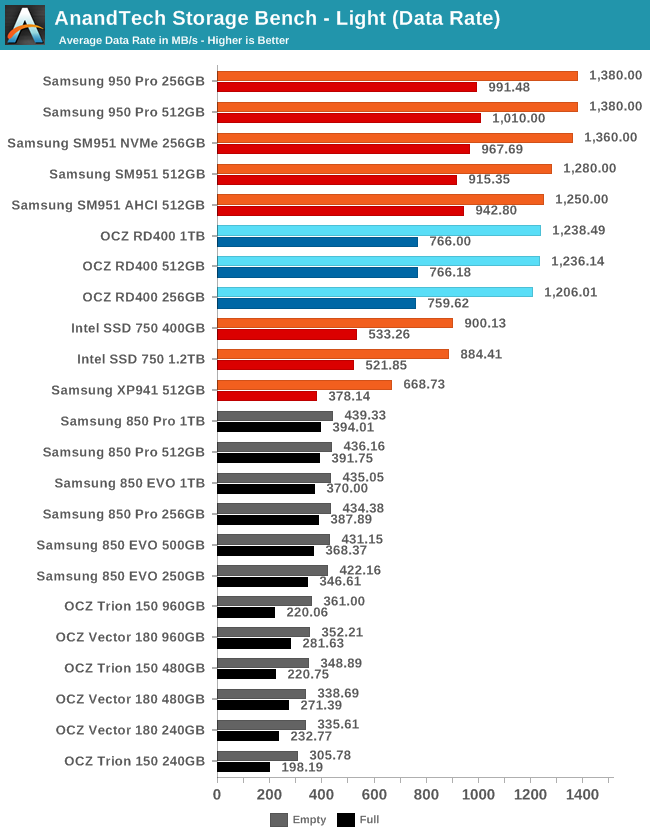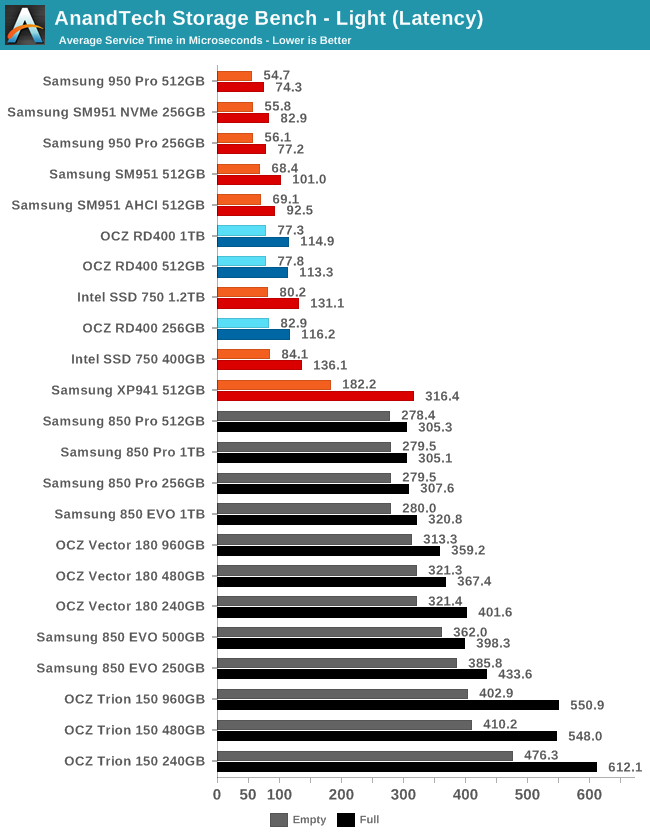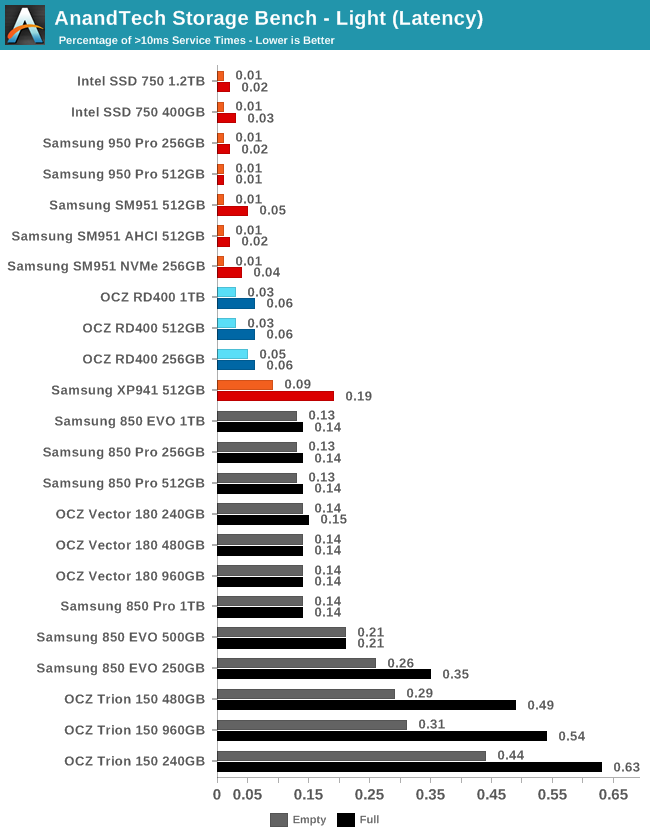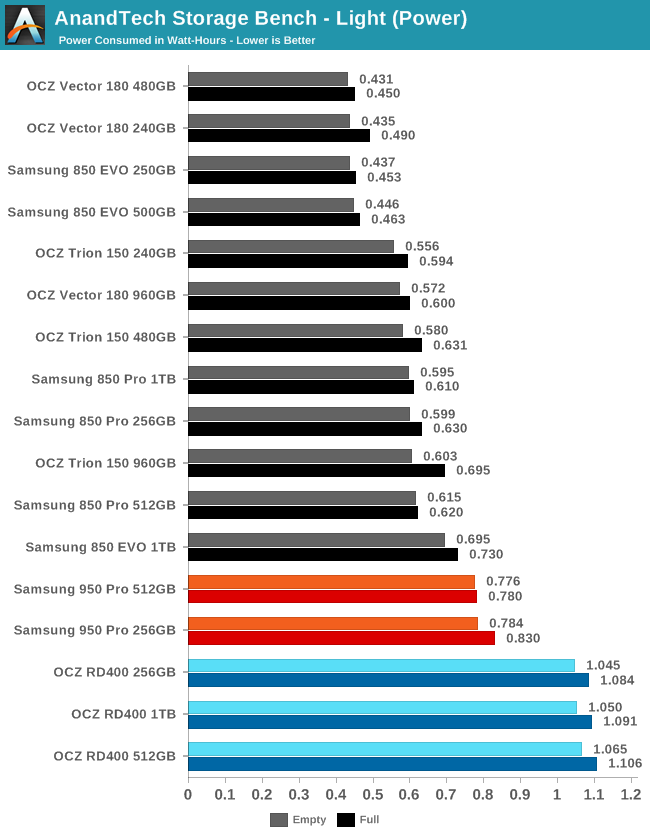The Toshiba OCZ RD400 (256GB, 512GB, 1TB) M.2 PCIe SSD Review
by Billy Tallis on May 25, 2016 8:02 AM ESTAnandTech Storage Bench - Light
Our Light storage test has relatively more sequential accesses and lower queue depths than The Destroyer or the Heavy test, and it's by far the shortest test overall. It's based largely on applications that aren't highly dependent on storage performance, so this is a test more of application launch times and file load times. This test can be seen as the sum of all the little delays in daily usage, but with the idle times trimmed to 25ms it takes less than half an hour to run. Details of the Light test can be found here.

As with the Heavy test, overall performance on the Light test shows the RD400 being slower than the Samsung PCIe 3 drives but faster than the Intel 750. In this case, the RD400 is much closer to the Samsung drives when fresh, but about halfway between Samsung and Intel for filled-drive performance.

Average service times again show that the differences between PCIe 3 drives are small compared to the gulf between them and SATA drives.

Latency outliers above 10ms are clearly more common with the RD400 than the other PCIe 3 drives, but still less than half as frequent as on any SATA drive. This time it's the 512GB and 1TB models showing a relatively large impact from the test being run on a full drive.

The RD400's energy usage is again worst overall with a significant gap between the Samsung 950 Pro and the RD400, and the 950 Pro already used more energy than most SATA drives.










40 Comments
View All Comments
tarqsharq - Wednesday, May 25, 2016 - link
Interesting article as always. I had been hoping for a larger price gap between this and the Samsung 950 Pro. At current prices, I think the choice is fairly obvious unless you need a 1TB SSD.Chaitanya - Wednesday, May 25, 2016 - link
You have a choice of Sandisk X400 as well if you want 1TB capacity in M.2 form factor.edzieba - Wednesday, May 25, 2016 - link
There's also the OEM version of the OCZ drive, the Toshiba XG3, which is also available in a 1TB m.2 SKU.Lord of the Bored - Thursday, May 26, 2016 - link
And who DOESN'T need a 1TB SSD?MrSpadge - Friday, May 27, 2016 - link
I think you're mixing up "want" and "need".DanNeely - Wednesday, May 25, 2016 - link
"Unlike most cheap adapter cards, the RD400's adapter draws power from the PCIe slot's 12V supply and converts it to the 3.3V required by the M.2 drive."PCIe slots provide 10W of 3.3V power directly. (I believe this was originally done to make converting legacy cards via a bridge chip easier.) Why would the card need to do any DC-DC conversion?
Byrn - Wednesday, May 25, 2016 - link
I'd assume that if they convert they can get cleaner 3.3V than if they use the feed through the PCIe slot, or that they can design in better resilience to sudden power demand changes...Basically, by converting I would have thought they can better fit the power supplied to the drive to the demands it makes.
digitalgriffin - Wednesday, May 25, 2016 - link
You can filter any volt feed with enough capacitors. But you lose power efficiency when you do.Alexvrb - Wednesday, May 25, 2016 - link
Yeah but they're filtering the power either way so converting from 12V -> 3.3V is less efficient than using 3.3V to start with. But getting back to what Byrn was saying... Byrn, they don't have a choice: This drive draws too much power to use the 3.3V supply.Look at idle power figures in this article. ~2.5W @ 12V. At 3.3V that would already be pushing it (right around 9W already). Under a load it's going to draw too much. So they had to use the 12V rail.
Wardrop - Wednesday, May 25, 2016 - link
2.5 watts is 2.5 watts. If it's a higher voltage, it's less amps, and vice versa. I think you've confused watts with amps?